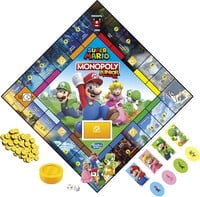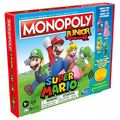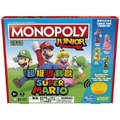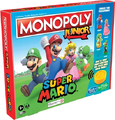Monopoly Junior: Super Mario
| Monopoly Junior: Super Mario | |
|---|---|
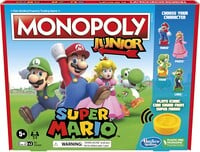
| |
| Manufacturer | Hasbro[1] |
| Publisher | Hasbro[1] |
| Release dates | |
| Languages | English Chinese (Traditional) French (Canadian) French (France) German Spanish (Latin America) Spanish (Spain) |
| Age rating | Five years and older |
| Number of players | 2–4 players |
Monopoly Junior: Super Mario is an edition of the board game Monopoly Junior that is themed after the Super Mario franchise and was released by Hasbro in April 2022.[1] Like the original game, the game revolves around players traveling around the board and buying properties, with the game ending when all properties have been bought. Like with Monopoly Gamer, all property names (with the exception of Bowser's Castle) are taken from world and level names in New Super Mario Bros. U, the game itself reusing the properties featured in this game. Also like Monopoly Gamer, the game also features a "power-up die," and coins replace the banknotes used in the original game. Playable characters in the board game include Mario, Luigi, Princess Peach, and Yoshi.
Gameplay[edit]
Setup[edit]
First, the player should choose someone to be the Banker, who is in charge of the Bank's money. Next, the Banker gives each player a set number of coins depending on how many players are in the game:
- Two players: 20 coins each
- Three players: 18 coins each
- Four players: 16 coins each
Each player then picks a character and takes their corresponding token and card, placing the token on GO. They also take their corresponding sold signs, which they place on all properties that they own. The player then shuffles the Chance cards and places the deck facedown on the Chance space on the board. Finally, they should place the Coin Sound Unit and dice near the gameboard where all players can reach them. The youngest player then goes first, with play passing to the player on their left.
Turn order[edit]
On their turn, the player rolls both the numbered and power-up dice and move their token the number of spaces indicated on the numbered die. After moving their token, they should follow the rules of the space they landed on. If the player rolled a coin on the power-up die, they collect coins this turn and should press the Coin Sound Unit, collecting the number of coins based on the number of "pings" that they hear from the unit. If the player rolled a Red Shell on the power-up die, they do not get to press the Coin Sound Unit for this turn. Play then passes to the player on their left.
Spaces[edit]
Properties[edit]
If the player lands on an unowned property and is able to afford it, they must buy the property. The player pays the Bank the amount shown on the space and places one of their sold signs on that space, showing that they now own the property. If the player lands on an unowned property and is unable to afford it, they do nothing.
If the player lands on a property someone else owns, they pay the player amount shown on the space. If they cannot afford to fully pay the rent, they should pay the player what they can. If the player lands on their own property, they do nothing.
There are sixteen properties and eight color sets on the board, with each color set containing two properties. Owning both properties in a color set allows the player to charge double rent on the properties in the set when other players land on them.
Chance spaces[edit]
If the player lands on a Chance space (represented by ? Block), they draw a card from the Chance deck and carry the actions stated on the card. If the card tells the player to pay the Bank or another player and they do not have enough money to pay the amount stated on the card in full, they should pay the Bank or player what they can. The player then places the Chance card at the bottom of the Chance deck after carrying out the actions on the card. The Chance cards included in this board game are as follows:
- Draw another Chance card and give this one to MARIO! – MARIO, on your next turn, go to any unowned property, and buy it.
- Draw another Chance card and give this one to LUIGI! – LUIGI, on your next turn, go to any unowned property, and buy it.
- Draw another Chance card and give this one to PEACH! – PEACH, on your next turn, go to any unowned property, and buy it.
- Draw another Chance card and give this one to YOSHI! – YOSHI, on your next turn, go to any unowned property, and buy it.
- Going up? You hitch a ride on a moving platform. – Go to a BROWN or YELLOW space. If no one owns it, get it for FREE! If someone owns it, pay rent.
- Wahoo! A cannon blasts you through the air! – Go to a LIGHT BLUE space. If no one owns it, get it for FREE! If someone owns it, pay rent.
- You jump over one of Bowser Jr.'s fireballs! – Go to a LIGHT BLUE or RED space. If no one owns it, get it for FREE! If someone owns it, pay rent.
- You make that giant leap over a bottomless pit! – Go to a PINK or DARK BLUE space. If no one owns it, get it for FREE! If someone owns it, pay rent.
- You throw balls of ice to freeze some Cooligans. – Go to an ORANGE space. If no one owns it, get it for FREE! If someone owns it, pay rent.
- Time is running out! Is there a secret exit? – Go to an ORANGE or GREEN space. If no one owns it, get it for FREE! If someone owns it, pay rent.
- You climb a vine to grab a 1-Up Mushroom! – Go to a RED space. If no one owns it, get it for FREE! If someone owns it, pay rent.
- Time to power up with the Penguin Suit! – Go to FROSTED GLACIER. If no one owns it, get it for FREE! If someone owns it, pay rent.
- You grab Bowser's spiny tail and send him for a spin! – Go to BOWSER'S CASTLE. If no one owns it, get it for FREE! If someone owns it, pay rent.
- Toadette surprises you with a gift! – MOVE forward 1 space or DRAW another Chance card.
- You kick a Green Shell to topple a line of Goombas! MOVE forward up to 5 spaces.
- You found a Fire Flower! Now you've got fire power! – Go to the GO space! Collect
 x2 from the Bank.
x2 from the Bank. - You find a Super Mushroom and now feel unstoppable! – Get out of Time Out free! Keep this card until you need it.
- You dodge a Thwomp so it can't flatten you! – Collect
 x2 from the Bank.
x2 from the Bank. - A Piranha Plant pops out of a pipe...chomp! – Pay
 x2 to the Bank.
x2 to the Bank. - You hit a Coin Block...again...and again...and again! – Collect
 x1 from each player.
x1 from each player.
Other spaces[edit]
If the player lands on GO, they collect two coins from the Bank.
If the player lands on Just Visiting or Free Parking, they do nothing.
If the player lands on Go to Time Out and they do not have any coins, they do not go to the In Time Out space. Instead, they remain on the Go to Time Out space until their next turn. If the player lands on Go to Time Out and they have coins, they move their token to the In Time Out space. The player does not collect two coins for passing GO or presses the Coin Sound Unit if they rolled a coin on the power-up die. While on the In Time Out space, the player can still collect rent from other players. The player can exit Time Out by using a Get Out of Time Out free card or paying one coin to the Bank. The player then places their token on the Just Visiting space, rolls both dice, and plays their turn as normal.
End of game[edit]
The game immediately ends when all properties have been bought. At that point each player counts up their coins, with the player with the most coins being the winner. If there is a tie, the tied player with the most properties wins the game.
Advanced game[edit]
The game is the same as the original version, but with the following changes:
- If the player does not have enough coins to pay rent or a Chance card, the player shoudl choose which property to give to the player or Bank. If the player is still unable to pay, they are bankrupt and the game ends. Every player then counts up their coins to determine the winner, with the player with the most coins winning the game.
Playing without sound[edit]
If the player chooses to player without the Coin Sound Unit, then, when checking the result of the power-up die, if the player rolled a coin, they roll the numbered die again, with the player receiving the number of coins based on the number they rolled on the die:
- If they rolled a 1 or a 2, they collect one coin from the bank.
- If they rolled a 3 or a 4, they collect two coins from the bank.
- If they rolled a 5 or a 6, they collect three coins from the bank.
Game contents[edit]
This is the list of contents included in the box seen on the cover of the instruction manual:
- Gameboard
- 4 Cardboard Character Tokens (with plastic bases)
- 4 Character Cards
- Coin Sound Unit
- 20 Chance Cards
- 48 Sold Signs (12 for each token)
- Power-up Die
- Numbered Die
- 90 Cardboard Coins
- Label Sheet
Characters[edit]
Like in Monopoly Gamer and Monopoly Gamer: Mario Kart, each Character token comes with its corresponding Character card. However, unlike these games, where each Character card gives their token a special ability the player can use as well as a bonus they receive when rolling a specific symbol on the power-up die, the Character cards in this game do not provide any special benefits, instead featuring a short biography about the character. The biographies for each character is as follows:
- Mario: "Mario has adventures through the Mushroom Kingdom and beyond."
- Luigi: "Mario's brother is not very good with ghosts, but he can be just as brave as Mario!"
- Peach: "Peach is the noble ruler of the Mushroom Kingdom."
- Yoshi: "Mario's faithful friend, Yoshi, has a big appetite―and a powerful hunger for adventure!"
Gallery[edit]
Names in other languages[edit]
| Language | Name | Meaning | Notes |
|---|---|---|---|
| Chinese (traditional) | Monopoly Junior 超級瑪利歐[2] Monopoly Junior Chāojí Mǎlì'ōu |
Monopoly Junior Super Mario | |
| French | Monopoly Junior: Super Mario[7] | - | |
| German | Monopoly Junior: Super Mario[4] | - | |
| Spanish | Monopoly Junior: Super Mario[5] | - |
References[edit]
- ^ a b c d Monopoly Juego de mesa Junior Super Mario Edition, divertido para niños a partir de 5 años, explora el reino de los hongos como Mario, Peach, Yoshi o Luigi (exclusivo de Amazon)
- ^ a b Monopoly大富翁兒童版超級瑪利歐
- ^ https://instructions.hasbro.com/api/download/F4817_fr-ca_monopoly-junior-super-mario-edition-board-game-ages-5-explore-the-mushroom-kingdom-as-mario-peach-yoshi-or-luigi.pdf
- ^ a b Hasbro Monopoly Junior Super Mario Edition Jeu de Plateau à partir de 5 Ans Joue dans Le Royaume des Champignons comme Mario, Peach, Yoshi ou Luigi, Multi(version Allemagne)
- ^ a b JUEGO DE MESA MONOPOLY SUPER MARIO
- ^ Monopoly Junior-bordspel: Super-Mario, vanaf 5 jaar, verken het paddenstoelkoninkrijk als Mario, Peach, Yoshi of Luigi
- ^ SUPER MARIO - MONOPOLY JUNIOR
